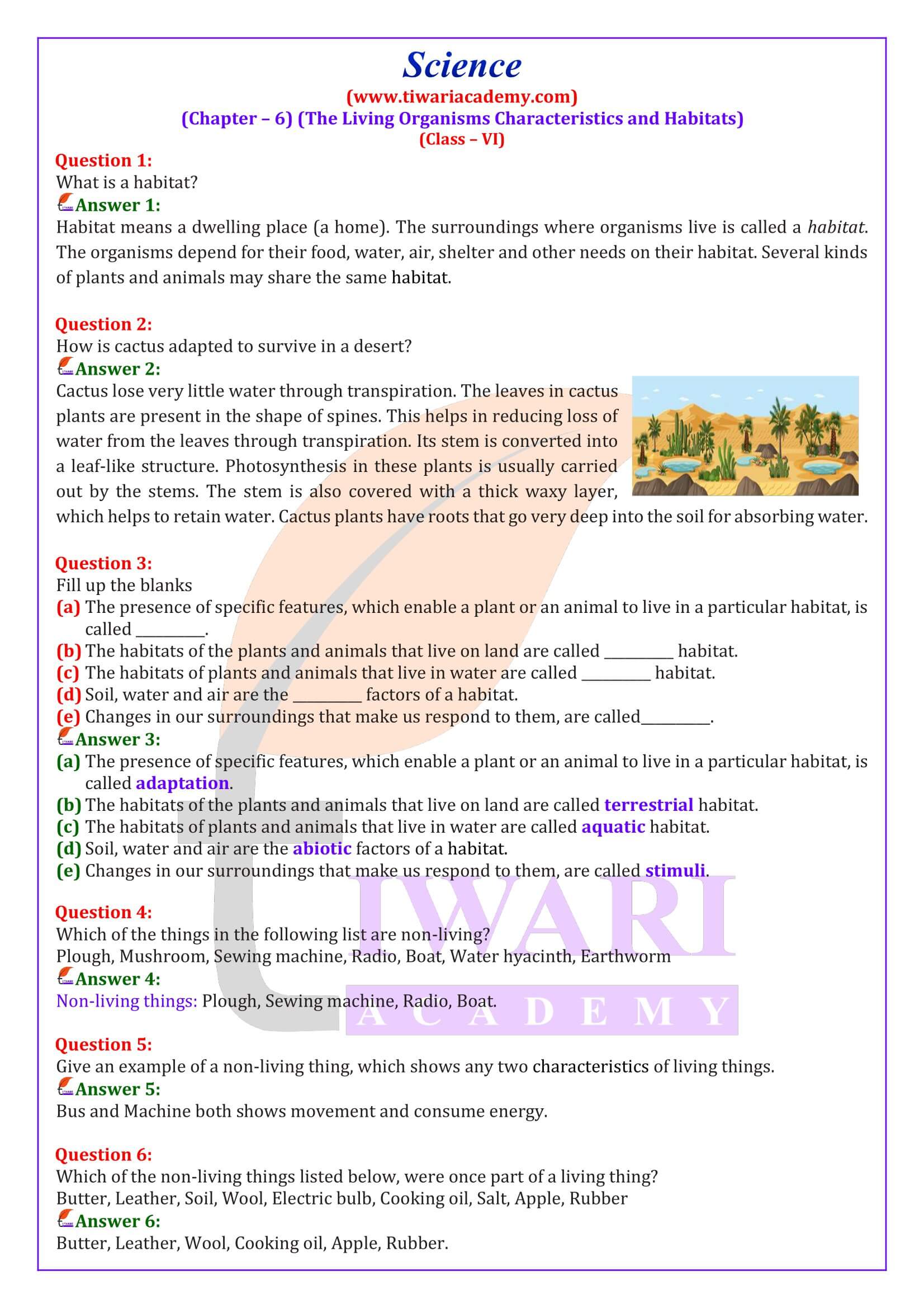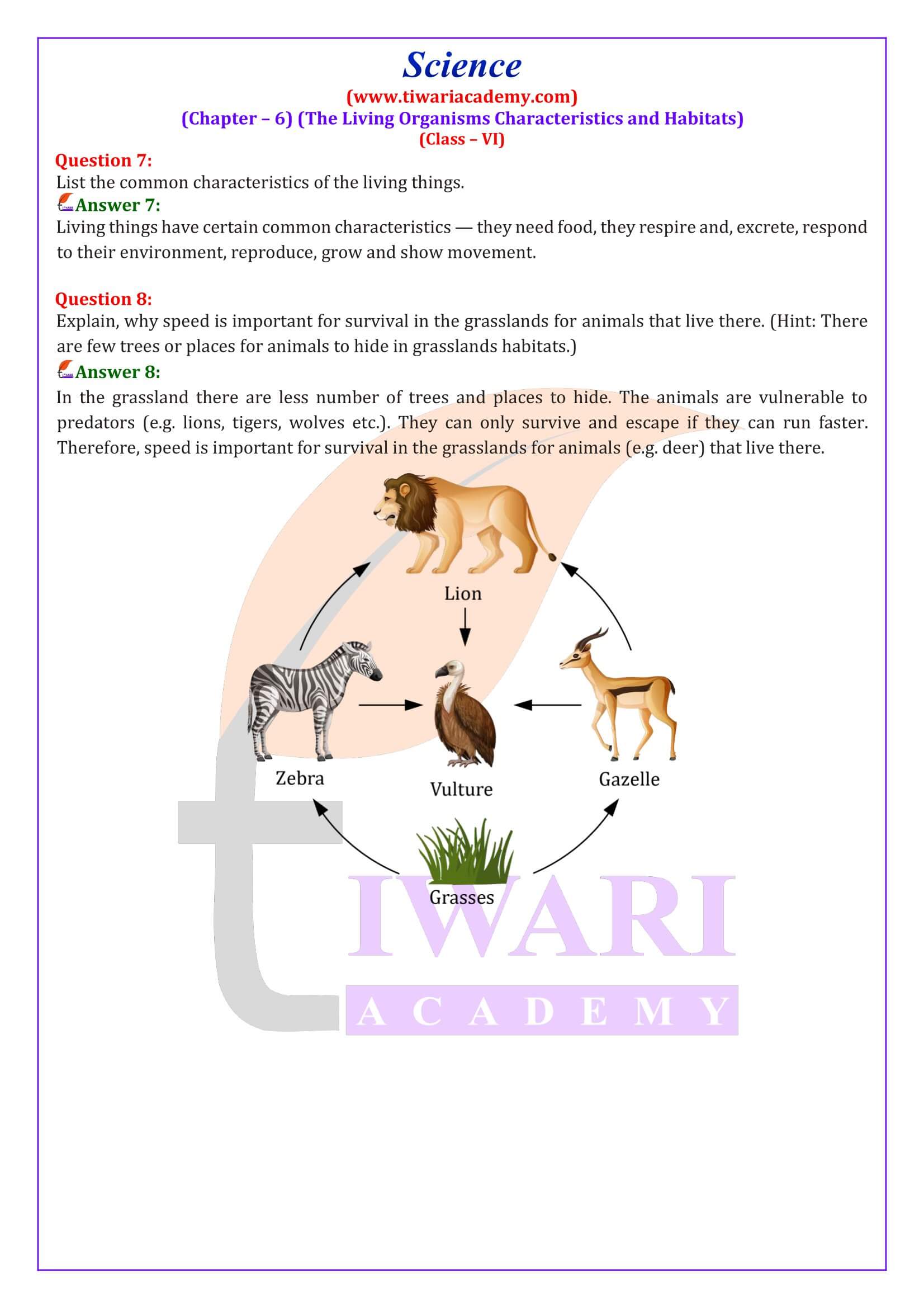NCERT Solutions for Class 6 Science Chapter 6 The Living Organisms Characteristics and Habitats in English and Hindi Medium for session 2025-26. The question answers and solutions of chapter 6 class VI science are revised according to new textbook issued for academic year 2025-26.
| Class: 6 | Science |
| Chapter 6: | The Living Organisms – Characteristics and Habitats |
| Content: | Exercise and Extra Questions |
| Content Type: | Online Videos and Text Format |
| Academic Session: | CBSE 2025-26 |
| Medium: | English and Hindi Medium |
NCERT Solutions for Class 6 Science Chapter 6
View all the solutions including key points of the chapter in Video Format based on latest NCERT Books in grade 6. Download CBSE Offline Apps for class 6 all subjects based on new CBSE Curriculum 2025-26. Ask Your Questions or Suggest your answers to help the others through Discussion Forum.
Important Questions on 6th Science Chapter 6 for Practice
1. Which of the following are characteristics of living beings?
(i) Respiration (ii) Reproduction (iii) Adaptation (iv) Excretion
Choose the correct answer from the options below:
(a) (i), (ii) and (iv) only (b) (i) and (ii) only
(c) (ii) and (iv) only (d) (i), (ii), (iii) and (iv)
2. Which of the following cannot be called a habitat?
(a) A desert with camels.
(b) A pond with fishes.
(c) A jungle with wild animals.
(d) Cultivated land with grazing cattle.
3. Which of the following is an incorrect statement about excretion?
(a) Excretion takes place in plants.
(b) Excretion takes place both in plants and animals.
(c) Excretion is the process of getting rid of excess water only.
(d) Secretion is one method of excretion.
4. Earthworms breathe through their
(a) skin (b) gills (c) lungs (d) stomata
Following are some features of plants
(i) They lose a lot of water through transpiration.
(ii) Their leaves are always broad and flat.
(iii) They lose very little water through transpiration.
(iv) Their roots grow very deep into the soil.
5. Which of the combination of above features are typical of desert plants?
(a) (i) and (ii) (b) (ii) and (iv) (c) (ii) and (iii) (d) (iii) and (iv)
6. Which of the following is not an example of response to stimulus?
(a) Watering in mouth when we see delicious food items.
(b) Closing of leaves of mimosa plant when touched.
(c) Shutting our eyes when an object is suddenly thrown in our direction.
(d) A chick hatching out of an egg.
7. Boojho comes across an animal having a stream-lined and slippery body. What is the habitat of the animal?
(a) Water (b) Desert (c) Grassland (d) Mountain
8. Which of the following is correct for respiration in plants?
(a) Respiration takes place only during day time.
(b) Respiration takes place only during night.
(c) Respiration takes place both during day and night.
(d) Respiration takes place only when plants are not making food.
Important Questions on Class 6 Science Chapter 6
How are cactus adapted to survive in a desert?
Cactus lose very little water through transpiration. The leaves in cactus plants are present in the shape of spines. This helps in reducing loss of water from the leaves through transpiration. Its stem is converted into a leaf-like structure. Photosynthesis in these plants is usually carried out by the stems. The stem is also covered with a thick waxy layer, which helps to retain water. Cactus plants have roots that go very deep into the soil for absorbing water.
Fill up the blank: The presence of specific features, which enable a plant or an animal to live in a particular habitat, is called __________.
The presence of specific features, which enable a plant or an animal to live in a particular habitat, is called adaptation.
Fill up the blank: The habitats of the plants and animals that live on land are called __________ habitat.
The habitats of the plants and animals that live on land are called terrestrial habitat.
Which of the things in the following list are non-living? Plough, Mushroom,
Sewing machine, Radio, Boat, Water hyacinth, Earthworm.
Non-living things: Plough, Sewing machine, Radio, Boat.
Give an example of a non-living thing, which shows any two characteristics of living things.
Bus and Machine both shows movement and consume energy.
Explain, why speed is important for survival in the grasslands for animals that live there.
In the grassland there are less number of trees and places to hide. The animals are vulnerable to predators (e.g. lions, tigers, wolves etc.). They can only survive and escape if they can run faster. Therefore speed is important for survival in the grasslands for animals (e.g. deer) that live there.
Answers of Important Questions
1 (d),
2 (d),
3 (c),
4 (a),
5 (d),
6 (d),
7 (a),
8 (c).
All answers are done properly based on new CBSE Syllabus and following the latest NCERT Books. Join the discussion forum to ask your doubts.





